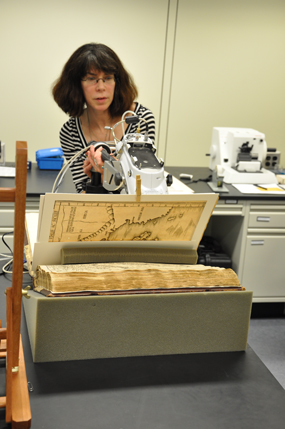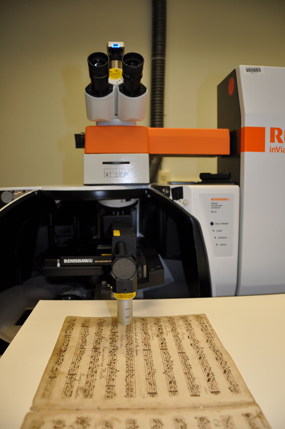The United States Constitution is more than 230 years old, and it’s falling apart. And so are many other documents written by America’s founding fathers. Conservators blame the type of ink used to pen the documents, so-called “iron gall ink.”
This ink, thought to have been used since antiquity, is made from small balls called galls, which form on oak trees. When a wasp lays its eggs in oak tree buds, and the bud grows around the developing wasp larva, the resulting structure is called a “gall.”
The problem for conservators is that they don’t know how specifically gall ink was made in historical times, so they don’t know the underlying chemistry of the ink. In the late 1600s, for instance, Isaac Newton described how to turn galls into ink by mixing them with various ingredients, including iron sulfate—hence the name, “iron gall ink.” He recommended immersing the mixture in “strong ale,” then setting it in the sun “for some time.” Historical recipes for the ink are no more detailed than Newton’s, and no two batches were the same.
According to Lynn Brostoff, a cultural heritage scientist and chemist at the U.S. Library of Congress, the first step in saving historical documents is to understand the chemistry of the iron gall ink used to make them. Through a series of tests using numerous analytical instruments, Brostoff has tried to do just that. She presented her findings in February at the American Association for the Advancement of Science meeting in Austin, Texas, where she spoke with SciCom's Kimberly Hickok.
Your field is unique, and there aren’t many scientists doing this. How did you get into studying the chemistry behind preserving historical artifacts?
I’m a bit of an oddball. I started as an art historian, and I got a master’s in art history. While I was doing my master’s I took a class called “Conservation for Art Historians,” and I was smitten. It was the chemistry behind art materials, primarily. I just thought it was really wonderful.
I trained to be an art conservator, and I became a paper conservator. But what I found that really evoked my passion was the science. So, I actually went back to school and got a master’s in material science and a Ph.D. in chemistry. It was a long, long route.
So right now you’re focused on studying iron gall ink. Why?
When I joined the Library of Congress, they were investigating the problem that many of these inks are water-sensitive. In other words, they can start to bleed a little bit if you are using water solutions for treatment, which is pretty common.
The conservators found that if they started adding alcohol to the water, the ink wouldn’t bleed.
And you wanted to know why that worked to stop the ink from bleeding. Why hadn’t that been done before?
There’s just not enough people and time to solve the problem.
Anybody who studies iron chemistry realizes that it’s very complex. Iron binds with so many things.
And it’s not just the chemistry of the ink, it’s the chemistry of the paper, and the sizing of the paper, and the gum Arabic. These are the messiest scientific samples that you will ever see. They’re never going to conform to theory perfectly.
How did your research add to what’s known about the chemical structure of iron gall ink?
Our study was important because the preservation treatments that are in use are based more on one of the structures published in the literature than the other. We were actually able to figure out the accurate structure by clarifying it with modern tools, such as single crystal x-ray diffraction.
That’s a technique that involves using X-rays to study the structure of crystals. What else did you find out about iron gall ink in your study?
We found out some interesting properties that people hadn’t realized could be significant for ink, such as the way that water is accommodated into the structure.
"These are the messiest scientific samples that you will ever see. They’re never going to conform to theory perfectly."
And none of that was known before?
It was proposed. But now we could say, “Yes, that’s right.” We clarified what was ambiguous in the literature. So that was really cool. But then I realized that we had only solved, at most, 10% of the ink.
Why only 10%?
Because we solved the structure of the solid. So you centrifuge it, and you get the solid and you get the liquid, but the liquid was highly colored. And color meant you had a compound producing color, and that’s 90% of the ink!
What do you plan to do now that you know this?
I consider the liquid part of the ink more like a dye, so now I want to understand that chemistry because that may be responsible for more of the properties of the ink. I’m thinking it might be responsible for the instability, but I don’t have that answer. This is science—we raise more questions than we answer!
What’s the coolest thing that you’ve worked on?
I love music. I was given a Beethoven manuscript to look at the ink. Hand-written. And it had all the crossing-outs. It was exactly what you’d think—it was all messy! It was all crossed out here, there. And they left me alone with it! I got to take it down to the lab where I can turn off the lights, and I put music on, and I’m there alone with my Beethoven music. It was really exciting.
Wow, that would be really tough to top! Why do you think the work you do is important?
Preserving things is really important. I believe strongly in that.
One of my very good friends is the head of conservation at The Holocaust Museum, and I worked with her on a diary that was written by a young man in hiding, and unfortunately, he died. It was the most powerful object. I had to excuse myself to go cry at one point. I’m telling you, this diary exuded power, it exuded the whole Holocaust—everything about it. Those objects can be very powerful. And preserving the record of the Holocaust—of course, there are Holocaust deniers.
There are different ways to preserve the history, and I think that what we do in my field is very important. Especially with a lot of naysayers and deniers out there, it’s important that we have physical records too. So these kinds of things, like this diary I worked on, are so compelling. They teach us a lot about what it means to be a human being.
_______________
© 2018 Kimberly Hickok. Kimberly preserves her portfolio at www.kimberlyhickok.com.


